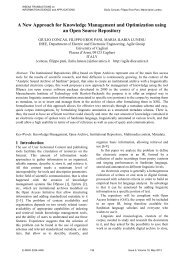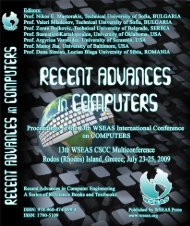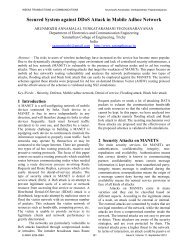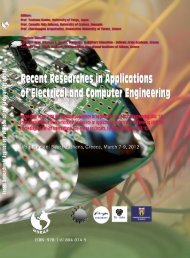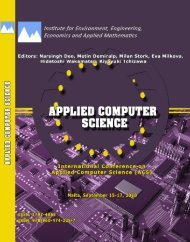RECENT RESEARCHES in APPLIED ECONOMICS and ... - Wseas
RECENT RESEARCHES in APPLIED ECONOMICS and ... - Wseas
RECENT RESEARCHES in APPLIED ECONOMICS and ... - Wseas
You also want an ePaper? Increase the reach of your titles
YUMPU automatically turns print PDFs into web optimized ePapers that Google loves.
Recent Researches <strong>in</strong> Applied Economics <strong>and</strong> Management - Volume II<br />
Plenary Lecture 1<br />
Approximation <strong>and</strong> Interpolation of Scattered n-Dimensional Economical Data<br />
Professor Václav Skala<br />
Fellow of the Eurographics Association<br />
Center of Computer Graphics <strong>and</strong> Visualization<br />
Department of Computer Science <strong>and</strong> Eng<strong>in</strong>eer<strong>in</strong>g<br />
Faculty of Applied Sciences<br />
University of West Bohemia<br />
Univerzitni 8<br />
CZ 206 14 Plzen, Czech Republic<br />
E-mail: skala@kiv.zcu.cz<br />
-also with-<br />
Department of Computer Science<br />
Faculty of Electrical Eng<strong>in</strong>eer<strong>in</strong>g <strong>and</strong> Computer Science<br />
VSB-Technical University of Ostrava<br />
17.listopadu 15/2172<br />
CZ 708 33 Ostrava-Poruba, Czech Republic<br />
E-mail: vaclav.skala@vsb.cz<br />
Abstract: Data approximation <strong>and</strong> <strong>in</strong>terpolation is one of the most often task <strong>in</strong> economical studies <strong>and</strong> eng<strong>in</strong>eer<strong>in</strong>g.<br />
Several techniques have been developed for data approximation <strong>and</strong> <strong>in</strong>terpolation, but they expect some k<strong>in</strong>d of data<br />
“order<strong>in</strong>g”. In many economical problems, data are not given <strong>in</strong> an ordered way <strong>and</strong> they can be considered as<br />
scattered <strong>in</strong> n dimensional space, <strong>in</strong> general. Usually scattered data are tessellated us<strong>in</strong>g triangulation,<br />
tetrahedronization etc. but for n dimensional data <strong>in</strong>terpolation this approach for is quite prohibitive because of the<br />
computational cost. An <strong>in</strong>terest<strong>in</strong>g technique is n dimensional data <strong>in</strong>terpolation us<strong>in</strong>g Radial Basis Functions (RBF).<br />
RBF <strong>in</strong>terpolation is computationally more expensive because <strong>in</strong>terpolated data are not ordered, but offers quite<br />
<strong>in</strong>terest<strong>in</strong>g applications with acceptable computational cost.<br />
We will shortly <strong>in</strong>troduce RBF theory at the “application level” <strong>in</strong>clud<strong>in</strong>g some basic pr<strong>in</strong>ciples <strong>and</strong> computational<br />
issues. There are two ma<strong>in</strong> groups of <strong>in</strong>terpolat<strong>in</strong>g functions: “global” <strong>and</strong> “local”. Application of “local” functions,<br />
called Compactly Support<strong>in</strong>g Functions-CSFBF, can significantly decrease computational cost as they lead to a<br />
system of l<strong>in</strong>ear equations with a sparse matrix. The RBF <strong>in</strong>terpolation will be demonstrated on practical applications.<br />
Brief Biography of the Speaker: Prof. Vaclav Skala is a Full professor of Computer Science at the University of<br />
West Bohemia, Plzen <strong>and</strong> VSB-Technical University Ostrava, Czech Republic. He received his Ing. (equivalent of<br />
MSc.) degree <strong>in</strong> 1975 from the Institute of Technology <strong>in</strong> Plzen <strong>and</strong> CSc. (equivalent of Ph.D.) degree from the Czech<br />
Technical University <strong>in</strong> Prague <strong>in</strong> 1981. In 1996 he became a full professor <strong>in</strong> Computer Science. In 1997 the Center<br />
of Computer Graphics <strong>and</strong> Visualization (CCGV) was formally established <strong>and</strong> s<strong>in</strong>ce then he is the Head of the<br />
CCGV <strong>in</strong> Plzen (http://Graphics.zcu.cz).<br />
Prof.Vaclav Skala is a member of editorial of The Visual Computer (Spr<strong>in</strong>ger), Computers <strong>and</strong> Graphics (Elsevier),<br />
Mach<strong>in</strong>e Graphics <strong>and</strong> Vision (Polish Academy of Sciences) <strong>and</strong> the Editor <strong>in</strong> Chief of the Journal of WSCG. He is a<br />
member of several <strong>in</strong>ternational program committees of prestigious conferences <strong>and</strong> workshops. He is a member of<br />
ACM SIGGRAPH, IEEE <strong>and</strong> Eurographics Association.<br />
Prof.Vaclav Skala has published over 200 research papers <strong>in</strong> scientific journal <strong>and</strong> at <strong>in</strong>ternational conferences. His<br />
current research <strong>in</strong>terests are computer graphics, visualization <strong>and</strong> mathematics, especially geometrical algebra,<br />
algorithms <strong>and</strong> data structures.<br />
Details can be found at http://www.VaclavSkala.eu<br />
ISBN: 978-960-474-324-7 13




